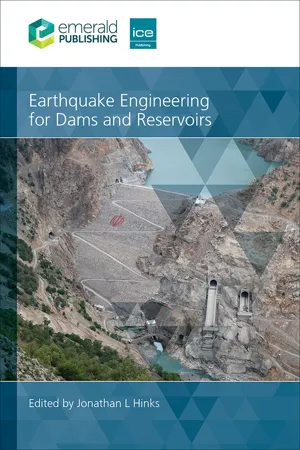
- 384 pages
- English
- PDF
- Available on iOS & Android
Earthquake Engineering for Dams and Reservoirs
About This Book
With contributions from many distinguished specialists from around the world, Earthquake Engineering for Dams and Reservoirs addresses all topics that will be of interest to students and professionals involved in the inspection or design of dams in seismic areas. Over recent years, research has developed rapidly in response to incidents worldwide where earthquakes have, either directly or indirectly, affected dams or their appurtenant structures. This title brings relevant data together in one well-collated volume of need-to-know information. It will help you to make decisions on the type of dam structure required for new projects and understand the issues that face existing dams and how to mitigate them.
With international case studies, in full colour, from regions with differing seismic activity levels, this book features coverage of:
- plate tectonics
- seismic input parameters
- reservoir triggered seismicity
- seismic design and performance criteria
- dams of various types including rockfill, concrete, earthfill, liquefaction, dams of hydraulic fill and tailing dams
- dams on active faults
- spillways, gates and equipment
- earthquake-triggered landslides, rockfalls, seismic seiches and instrumentation.
This is essential reading for any engineer, or designer, tasked with building, retrofitting or maintaining dams in all seismically active regions. It will also appeal to dam owners and managers, writers of feasibility studies and students of engineering.
Frequently asked questions
Information
Table of contents
- Half Title Page
- Title Page
- Copyright Page
- Contents
- Acknowledgements
- About the editor
- About the contributors
- Abbreviations
- Chapter 1 Introduction
- Chapter 2 Earthquakes – an overview
- Chapter 3 Seismic input parameters
- Chapter 4 Reservoir-triggered seismicity
- Chapter 5 Seismic design criteria
- Chapter 6 Choice of dam type
- Chapter 7 Seismic design of rockfill dams
- Chapter 8 Concrete dams
- Chapter 9 Earthfill dams
- Chapter 10 Dams with asphaltic membranes or cores
- Chapter 11 Dams with PVC membranes
- Chapter 12 Liquefaction
- Chapter 13 Dams built with hydraulic fill
- Chapter 14 Tailings dams
- Chapter 15 Dams on active faults
- Chapter 16 Appurtenant structures and equipment
- Chapter 17 Earthquake-triggered landslides
- Chapter 18 Rockfalls
- Chapter 19 Seismic seiches and displacement waves
- Chapter 20 Instrumentation and post-earthquake inspections
- Chapter 21 Conclusions
- Index